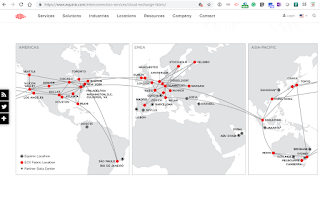5G Americas, which is an industry trade organization composed of leading telecommunications service providers and manufacturers, highlighted key advancements in 3GPP Releases 16-17 - the next steps in the evolution of 5G.
 Release 16 is an evolutionary development that will positively impact multiple industries and is expected to be finalized in March 2020. Release 17 provides additional improved radio flexibility and will be 3GPP’s focus in 2020 and 2021 with target standard finalization in July 2021.
Release 16 is an evolutionary development that will positively impact multiple industries and is expected to be finalized in March 2020. Release 17 provides additional improved radio flexibility and will be 3GPP’s focus in 2020 and 2021 with target standard finalization in July 2021.
3GPP Release 16 enhancements include:
3GPP Release 17 improvements include:
A whitepaper outlining these specifications is on the 5G America's website.
 In addition, 5G Americas noted that there were approximately five million 5G subscriptions at the end of 2019, a number forecast to increase to 1.9 billion by 2024, according to data from Ovum. Additionally, the number of IoT connections is expected to quadruple from one billion to over four billion during the same time frame.
In addition, 5G Americas noted that there were approximately five million 5G subscriptions at the end of 2019, a number forecast to increase to 1.9 billion by 2024, according to data from Ovum. Additionally, the number of IoT connections is expected to quadruple from one billion to over four billion during the same time frame.
Chris Pearson, President of 5G Americas said, “The age of smartly connecting everything is here. The rapid increase in 5G-connected devices will be largely due to increased technical capabilities of networks and devices standardized by 3GPP for commercial roll outs.”
 Release 16 is an evolutionary development that will positively impact multiple industries and is expected to be finalized in March 2020. Release 17 provides additional improved radio flexibility and will be 3GPP’s focus in 2020 and 2021 with target standard finalization in July 2021.
Release 16 is an evolutionary development that will positively impact multiple industries and is expected to be finalized in March 2020. Release 17 provides additional improved radio flexibility and will be 3GPP’s focus in 2020 and 2021 with target standard finalization in July 2021.3GPP Release 16 enhancements include:
- Radio access technology improvements include enhancements for LTE-MTC, NarrowBand-IoT, Downlink Multi-In Multi-Out (DL “MIMO”) efficiency, mobility, performance in high speed scenarios and 5G terrestrial broadcasts. Features of Release 16 boast enhanced capacity and improvement of operation efficiency including: MIMO enhancements, Integrated Access and Backhaul, Cross Link Interference/Remote Interference Management, User Equipment (UE) Power Savings, Mobility Enhancements, Multi-Radio Access Technology (“Multi-RAT”) dual connectivity and Carrier Aggregation enhancements, Ultra-Reliable Low Latency Communications (URLLC), NR Unlicensed, NR Positioning, and 2-Step Random Access Channel (“2-Step RACH”).
- Network core architecture enhancements include Service-Based Architecture, improved flexible deployments of Session Management Control Function (SMF) and User Plane Function (UPF), support for commercial services using location-based service architecture, enhancements to UE capability signaling, RAN Self-Organizing Networks, and Dual Connectivity and Carrier Aggregation improvements.
3GPP Release 17 improvements include:
- Radio access technology improvements that add more capabilities, including NR Beyond 52.6 GHz spectrum, Dynamic Spectrum Sharing improvements, Integrated Access and Backhaul (IAB) enhancements, NR-Light (Reduced Capability NR devices), Small Data Enhancements, more V2X enhancements and General Sidelink Communication, NR Broadcast and Multicast, and Multi-SIM support.
- Network system upgrades include support for new services for asset tracking, audio-visual service production, communication service requirements for critical medical applications, service requirements on enhancements for cyber-physical control applications in vertical domains, multimedia priority services (phase 2), support for Multi-SIM devices, enhanced relays for energy efficiency and extensive coverage, and others.
- Erik Dahlman, Senior Expert at Ericsson Research and leader for the project, said: “The evolution and revolution in wireless continues with new standardized technical features at 3GPP as the mobile wireless industry connects more people and things in existing and new markets. The defined cellular technology roadmap and success of the wireless industry is a demonstration of 3GPP’s well-defined approach to structure and consensus process.”
A whitepaper outlining these specifications is on the 5G America's website.
 In addition, 5G Americas noted that there were approximately five million 5G subscriptions at the end of 2019, a number forecast to increase to 1.9 billion by 2024, according to data from Ovum. Additionally, the number of IoT connections is expected to quadruple from one billion to over four billion during the same time frame.
In addition, 5G Americas noted that there were approximately five million 5G subscriptions at the end of 2019, a number forecast to increase to 1.9 billion by 2024, according to data from Ovum. Additionally, the number of IoT connections is expected to quadruple from one billion to over four billion during the same time frame.Chris Pearson, President of 5G Americas said, “The age of smartly connecting everything is here. The rapid increase in 5G-connected devices will be largely due to increased technical capabilities of networks and devices standardized by 3GPP for commercial roll outs.”






















